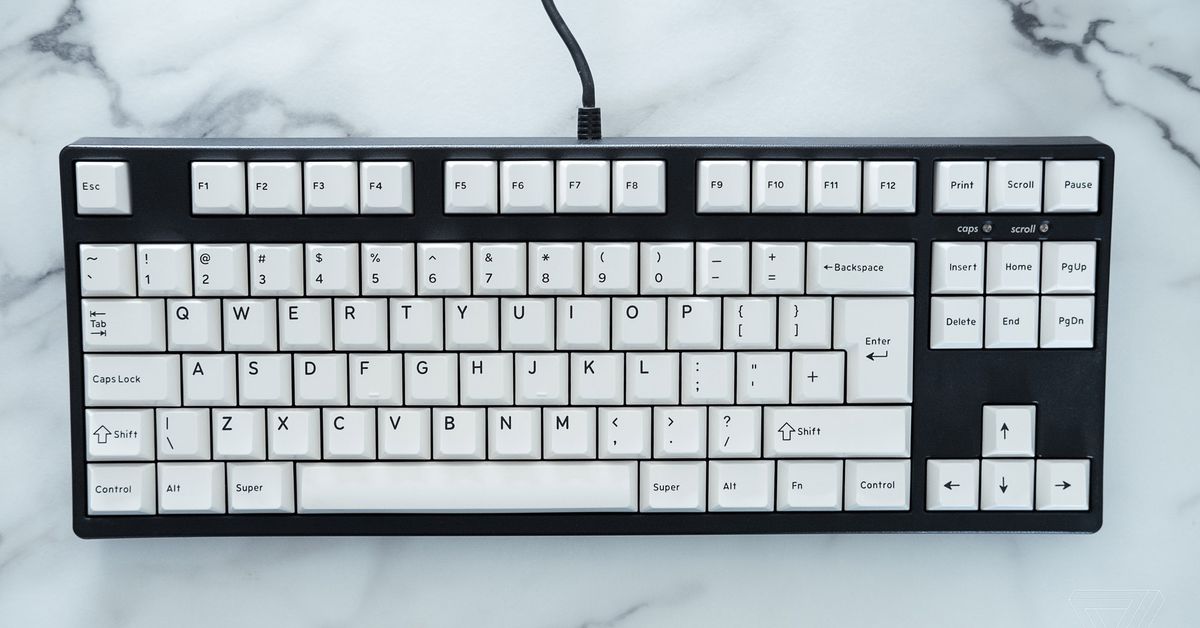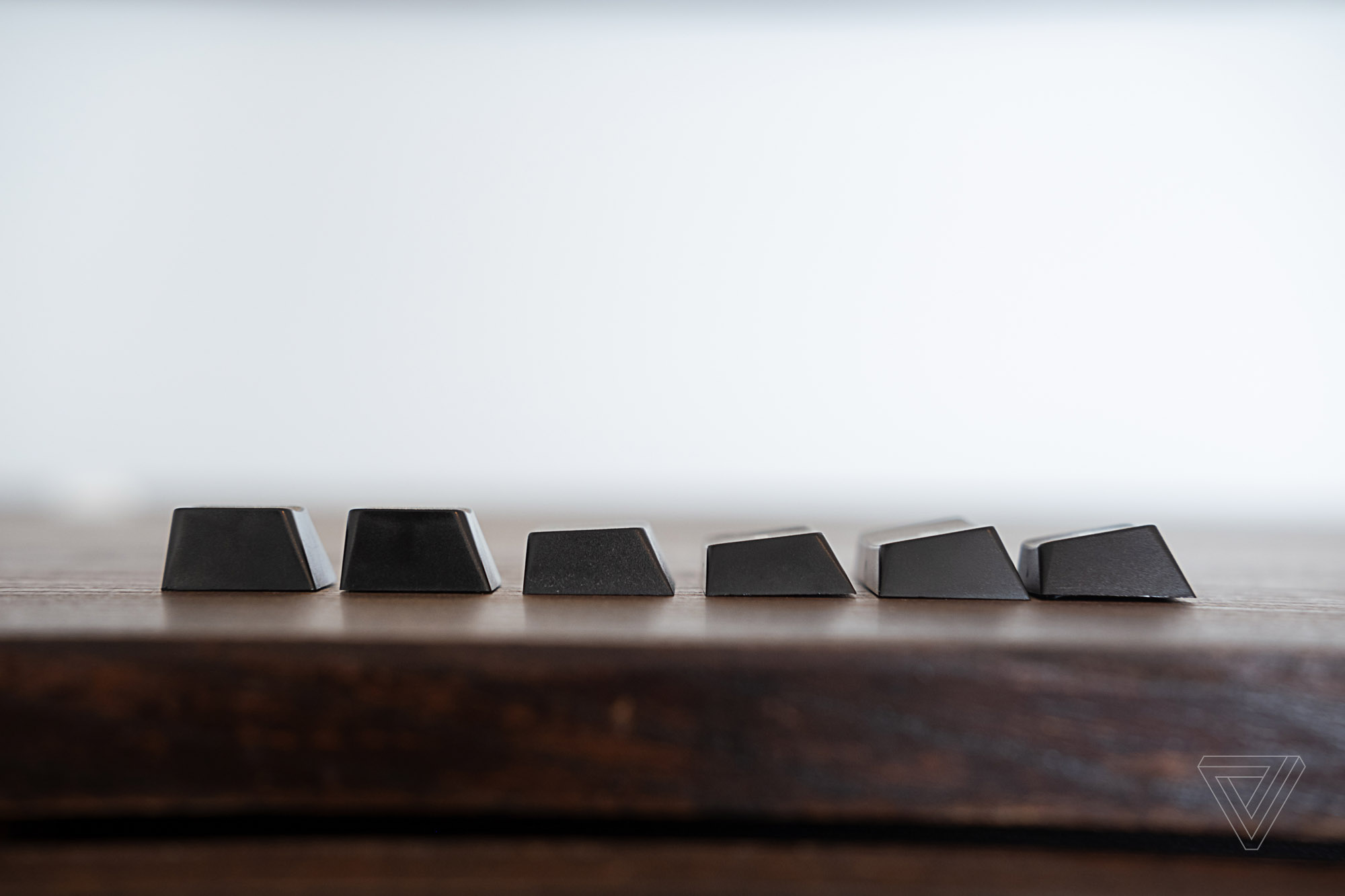The delight is in the details of Drop’s new DCX keycaps
Earlier this year, keyboard specialist Drop announced its new lineup of DCX keycaps. But rather than focusing on making flashy, colorful designs like most aftermarket keycaps, the first three sets to use the new DCX profile are relatively understated, with simple black-and-white designs or a small selection of primary colors.
That’s because the focus here is on getting the tiniest details right in the hopes that Drop’s sets might be able to compete directly with GMK’s — a German manufacturer commonly seen as the producer of some of the best-quality keycaps around. GMK produces keycaps in the “Cherry” profile (which refers to the overall shape of the keycaps) while “DCX” refers to the profile of Drop’s keycaps. I’ve had the chance to compare Drop’s new black-on-white DCX keycaps directly with a set of white-on-black keycaps produced by GMK. Both are sold by Drop, but its DCX keycaps start at $89 for a base kit, while GMK’s cost $110. And you know what? I think I prefer Drop’s (slightly) more affordable keycaps.
:no_upscale()/cdn.vox-cdn.com/uploads/chorus_asset/file/23617515/VRG_PHOTO_5279_DropDCX_Keycaps_DSCF0667.jpg)
:no_upscale()/cdn.vox-cdn.com/uploads/chorus_asset/file/23617518/VRG_PHOTO_5279_DropDCX_Keycaps_DSCF0684.jpg)
At first glance, the two sets look very similar. Both are made out of thick ABS plastic, both are double-shot (their legends are made from a second piece of plastic for added durability), and both have a so-called “cylindrical” design. This name can be confusing because the overall shape of the keycaps is relatively square, but look at them from the front, and you’ll see that they’re concave, as though you could place a cylinder vertically across each keycap. Like GMK’s, Drop’s keycaps reportedly have slight fit issues with north-facing switches.
The standard sets of both keycaps also include a variety of extra keycaps that you won’t find on a standard US keyboard, like the smaller left shift and the larger enter key you’ll see on my UK keyboard in these images. There are also a couple of different size options when it comes to bottom-row keys in an attempt to cater to the variety of keyboard layouts in use today.
Look closer, however, and the differences start to become obvious. For starters, Drop is using different wording on its bottom row. There’s still no Windows key, but Drop has gone with “Super” in a nice nod to the keys historically found on Linux computers, rather than “Code” on GMK’s sets. The fonts of the two keycaps are also subtly different: GMK’s lettering looks ever so slightly bolded compared to Drop’s. But I don’t think either is necessarily “better” here — whichever you like more will come down to personal preference.
There are other areas where I think Drop’s keycaps have a slight edge. Across the keycaps, the sizing of the lettering and symbols is far more consistent. The sizes of the caret (aka the little “^” hat) and tilde (~) symbols have been reduced significantly to be much more in line with the other symbols on their respective keys. So, too, has the sizing of the arrows on the tab key been adjusted. Everything just looks a lot neater overall.
I’ve only been typing on these keycaps for a day or so, so it’s hard to draw too many firm conclusions about how the plastic might wear over time. Out of the box, it has a great finish, but since it’s ABS, it’s reasonable to assume it’ll develop at least some shine as it smooths down with use. Bear in mind with my comparison shots that the GMK keycaps I’m comparing them to have been in more or less continuous use for a year and a half, hence the extra glossiness.
Since some people will inevitably ask about how the keycaps sound, I recorded a couple of typing tests. I’ll be the first to admit that I don’t have the cleanest sounding keyboard around (it’s a Filco Majestouch 2, with its characteristically rattly Costar-style stabilizers), but I could barely tell the difference between the two.
To be clear, none of DCX’s features offer a night-and-day improvement compared to what’s available from GMK. And as it currently stands, you still have a lot more options for different color schemes if you go down the GMK route. That’s the main problem with DCX at the moment: there’s only a very limited number of color schemes available. They might be high-quality, but they don’t offer the colorfulness and fun that draw many people to aftermarket keycaps. It’s fun to obsess over the details of a black-and-white set of keycaps, but at $90, it’s not a purchase I’d recommend for anyone outside of the truly obsessive.
But if Drop is able to keep up this level of quality as it builds out its range of DCX keycaps, and if it’s able to do so while keeping them more affordable and more readily available than GMK’s sets, then they’ll start to become very easy to recommend.
Photography by Jon Porter / The Verge
For all the latest Technology News Click Here



